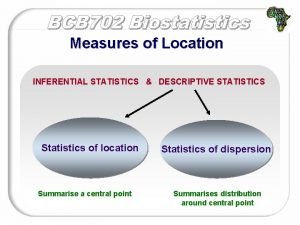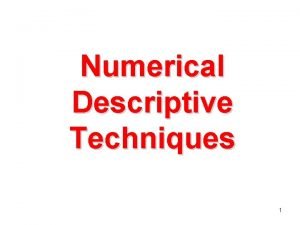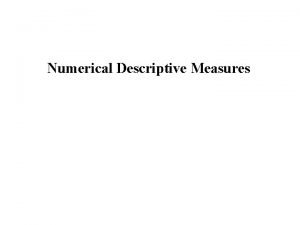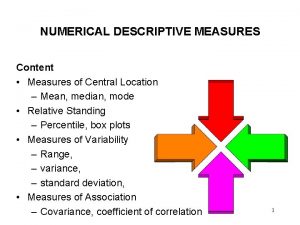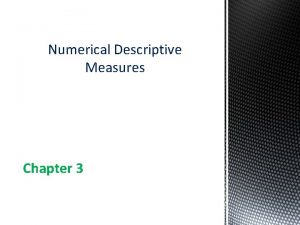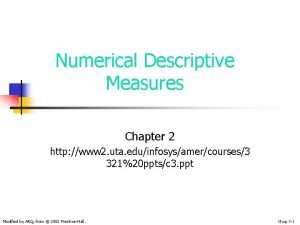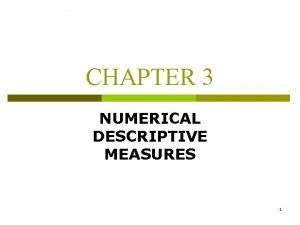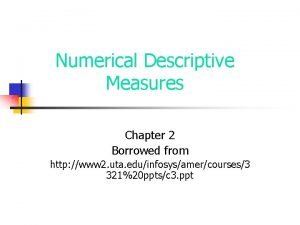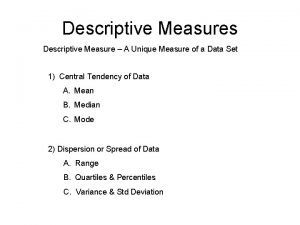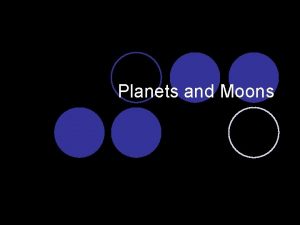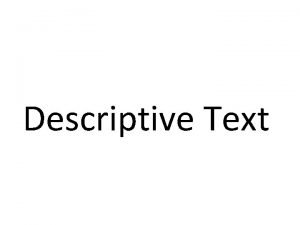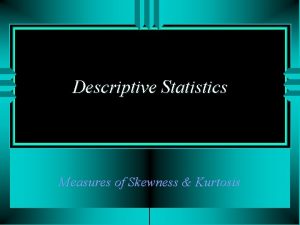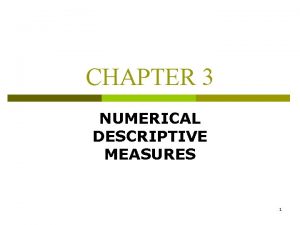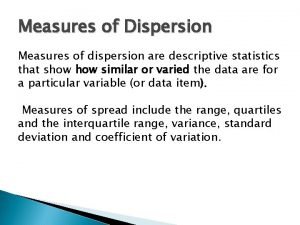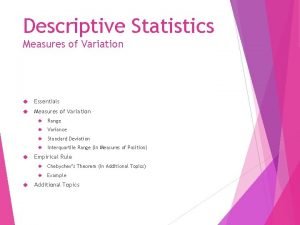Descriptive Measures Descriptive Measure A Unique Measure of




















- Slides: 20

Descriptive Measures Descriptive Measure – A Unique Measure of a Data Set 1) Central Tendency of Data A. Mean B. Median C. Mode 2) Dispersion or Spread of Data A. Range B. Quartiles & Percentiles C. Variance & Std Deviation

A. Mean – Arithmetic Mean ( Average ) Ex: 1 3 3 5 8 B. Median – Midpoint of the Data – as many observations above as below 1 3 3 5 8 10

C. Mode – Most Frequent Observation 1 3 3 5 8 Relationship between Mean, Median, & Mode 1) Symmetrical Distribution

2) Right Skewed Distribution (Positive Skew) 3) Left Skewed Distribution (Negative Skew)

We can Transform Data to Change Distribution Shape

Mammal: Brain vs Body

Log(Brain) vs Log(Body)

Variability or Dispersion of Data EX 1: 2 3 3 4 EX 2: 1 2 4 5 EX 3: 0 A. Range = Maximum Obs – Minimum Obs B. Quartiles – Divide the Data into Four Equal Groups 25% Obs ≤ Q 1 ≤ 75% Obs Lower Quartile 50% Obs ≤ Q 2 ≤ 50% Obs Middle Quartile 75% Obs ≤ Q 3 ≤ 25% Obs Upper Quartile 2 4 6

Interquartile Range – IQR = Q 3 – Q 1 Percentiles – the Pth Percentile is the Value such that at most P% of the Observations are Less and at most (100 – P)% of the Observations are Greater than the Value. Method: Multiply P*n: If result is integer, the Percentile is midpoint between this obs & next. If result is decimal, the Percentile is the next observation Q 1 = Q 2 = Q 3 = P 80 = P 95 =

Box & Whisker Plot for Data: Minimum Q 1 Q 2 Q 3 Maximum Distance of Obs from Box > 1. 5 * IQR – Mild Outlier (*) Distance of Obs from Box > 3. 0 * IQR – Extreme Outlier (0)

C. Variance and Standard Deviation Ex: Xi 1 3 Deviation from Mean Average Deviation = Mean Absolute Deviation (MAD) = Squared Deviations Average Squared Deviation = (Variance) 3 5 8

Sample Variance Sample Std Deviation Ex: 2 1 3 Ex: 3 1 3 3 5 5 6 7 6 14

Significance of the Standard Deviation Tchebysheff’s Theorem – (k > 1) At least (1 -(1/k 2)) of observations will lie within k std dev of the mean. K=2 1 -(1/4) = 75% of obs will lie within 2 std dev of mean K=3 1 -(1/9) = 89% of obs will lie within 3 std dev of mean Empirical Rule: For Normal Data µ ± 1σ 68% Obs µ ± 2σ 95% Obs µ ± 3σ 99. 7% Obs


Shortcut Formula for the Variance Shortcut/Machine Formula

Ex: 4 Xi 2 1 3 3 5 8 9 11


Estimate Mean and Variance for Grouped Data fj – Class Freq mj – Class Mark Mean Variance Example: Sales Freq 0 10 1 5 2 3 3 2 4 1 21

Example: Age Freq 17 – 20 18 21 – 24 12 25 – 28 8 29 – 32 2 40 Estimate Median: fj*mj 2

Anscombe Quartet
 Descriptive statistics
Descriptive statistics Anova repeated measures
Anova repeated measures Descriptive statistics numerical measures
Descriptive statistics numerical measures Jack box
Jack box Descriptive measures
Descriptive measures Numerical descriptive measures
Numerical descriptive measures Numerical descriptive measures exercises
Numerical descriptive measures exercises Numerical descriptive measures
Numerical descriptive measures Numerical descriptive statistics
Numerical descriptive statistics Numerical descriptive measures
Numerical descriptive measures Gibbons jacobean city comedy download
Gibbons jacobean city comedy download Air temperature
Air temperature Descriptive measure
Descriptive measure Feature of mercury
Feature of mercury Why is each point on earth unique?
Why is each point on earth unique? Phrase unique
Phrase unique Hobby o hobbie
Hobby o hobbie The cuticle varies in its
The cuticle varies in its E-commerce: digital markets, digital goods
E-commerce: digital markets, digital goods Lesson 1 greek culture answer key
Lesson 1 greek culture answer key Maltese christmas traditions
Maltese christmas traditions
